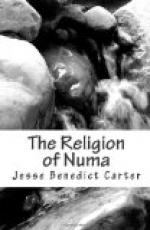At different points in Asia Minor and in Crete a goddess was worshipped, originally without proper name, as the great source of all fertility, the mother of all things, even of the gods. Mount Dindymos in Phrygia was one of the chief centres of the cult, and there the Great Mother was known also as Cybele. From these various centres the cult spread over all the Greek world, but wherever it went, it always gave evidence of its birthplace by certain strange Oriental elements both in its myths and in its rites. Its devotees were a noisy orgiastic band, who filled the streets with their dances, and the air with their singing and the clashing of their symbols, to the accompaniment of the rattling of coin in the money box—for the collection of money from the bystanders was always a part of the performance.
This then was what the “best man in the state” and the grave Roman matrons went forth from Rome to receive—a sacred stone representing the goddess, and a band of noisy emasculated priests; and this was what they opened their gates to, and took up into their holy of holies, the Palatine hill, the birthplace of Rome. The Greeks had again come bearing gifts, and like the Trojans who broke down their walls and took the wooden horse up into their citadel, Romans, the reputed descendents of these Trojans, were carrying up to their most sacred hill another gift of Greece which was to capture their city. They put the image in the temple of Victoria on the Palatine until such time as its own temple was ready to receive it, and the goddess of Victory seemed to respond to its presence, for did not Hannibal leave Italy the very next year? And who would be so impious as to suggest that to Scipio and not Cybele belonged the glory, and that a strong Roman army in Africa affected Hannibal more than a sacred stone on the Palatine?
It may well be doubted whether anything but such a great exigency would ever have induced Rome to accept such an utterly foreign cult; and when the nightmare of the war was past, the Senate awoke to the realisation that a very serious act had been committed. To their credit be it said that they did what they could to minimise the evil. The goddess had brought her own priests with her, the cult was in their hands, and there the law decreed it must stay, and no Roman citizen could become a priest. That this law was really enforced is shown by several cases where punishment, even transportation across the sea, was meted out to transgressors. Then too the worship must be in the main confined to the precincts of the temple on the Palatine, and only on certain days of the year were the priests allowed to perform in the streets of the city. It is significant of the strength of Roman law that these enactments held good for three and a half centuries, and were not changed until the reign of Antoninus Pius.




